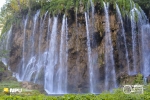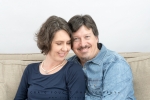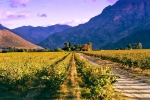











During mid-August I took a weekend trip to view the Spring flowers of Namaqualand, the Hantam Karoo and bulb capital of the World – Nieuwoudtville, as well as Calvinia, Loeriesfontien and Vanrhynsdorp in the West Coast & Namaqualand region of South-Africa. A week later I also visite dthe West Coast National Park in the Postberg area which is managed by SANParks. The Northern Cape is internationally known for a diverse flora and fauna species. Nieuwoudtville is a renowned tourist attraction due to the wide selection of indigenous flowers. The small town received an abundance of rain this year which was enough to ensure a bumper spring flower spectacle which we are currenlty experiencing.
Incredible carpets of striking flowers dot the landscape all along the R27 and N7 north. An artists pallet of many colours sways and dazzles in the wind. Timing is crucial. Warm sunny days cause the fields to burst forth in colourful joy, and the wind blows through the trees and they clap their hands as they announce Spring! Each new day announces a new field of colour that was either increased or not there the day before.
Due to the size of the video and limitations imposed by my ISP I am unable to upload it here. Please click on the button and let your senses awaken to the sights and splendor of the Spring flowers of Namaqualand.
A
Namaqualand extends from the Atlantic Ocean on the west coast, to the little town of Pofadder in the east, to the Orange River in the north, south to Garies, and includes the Hantam Karoo, along the southern border of the Northern Cape. Regarded as a portion of the Succulent Karoo, Namakwa (Namaqualand) forms part of the only arid hotspot in the world; is regarded as a biodiversity hotspot, and as such boasts the richest succulent flora on Earth.
The Namaqualand region of the Northern Cape is imbued with the story of the Namaqualand daisies; a brimming over of fertile flowers that transform the almost lifeless Namaqualand into an exquisite floral display of beauty during spring. One for which people are more than willing to enter the hinterland of South Africa’s Northern Cape, to discover that the unspoilt vastness of Namaqualand and Hantam Karoo, which make up Namaqualand, is far more than an area of sweltering extremes and dry earth under unforgiving skies.
Namaqualand is indeed a thirsty earth, but one that is fascinating to travel. For visitors the explosion of wild flowers along the flower route from Springbok’s Goegap Nature Reserve to Kamieskroon’s Skilpad Wild Flower Reserve, is a phenomenon that combines incredible landscapes through remote little towns, like Pofadder, the Richtersveld National Park, the Hester Malan Wild Flower Garden, and the Namaqua National Park.
The narrow window between July and September, in which the Namkwa casts off its dowdy desert cloak to transform its barrenness, relies heavily on good rainfall just before spring.
But then the Namaqualand is not its flowers alone. Little historic towns that include quaint names like Kamieskroon, Aggeneys, Garies and Nieuwoudtville, are as much a part of the landscape as the incredible flora.
Vanrhynsdorp is situated in the folds of the towering Matzikamma and Gifberg Mountains on the N7, 300 km north of Cape Town, en route to Namibia along the Cape West Coast region of Namaqualand.
Vanrhynsdorp is in administrative terms part of the Western Cape Province, but geographically, is part of the Namaqualand Region and is the hub of the flower routes. This is the start of the the vast, semi-desert Nama Karoo, with its typical vegetation of succulents and semi-arid climate.
For a short time every year (after good winter rains, around August to September) the countryside here erupts into a show of colour as spans of wildflowers bloom. Vanrhynsdorp’s location is an ideal base from which the Namaqualand flower areas may be explored.
Home to a succulent nursery that is the largest of its kind in the world. This nursery has become the centre of preservation of a large variety of indigenous succulents. These fascinating plants attract the attention of visitors from all over the world as the nursery houses some 500 species of indigenous succulents of which about 50 are endemic to the area.
Loeriesfontein may be a small town in the sparsely populated South African province of the Northern Cape, but it has plenty in the way of natural beauty and tourist attractions to offer its visitors. This little town is tucked away in the Hantam region of the Upper Karoo, 120 kilometres from Brandvlei. Other nearby towns include Nieuwoudtville and Calvinia.
It is situated in a basin and surrounded by the beautiful mountain ranges of the Northern Cape. The south-western part of the town is part of the Namaqualand, known the world over for its proliferation of wild flowers during the South African spring time. People flock from all corners of the globe to experience the natural loveliness of about 4 000 different flower species.
This town plays an important role in the sheep farming and salt mining industries of South Africa.
The Quiver Tree Forest is one of the largest of its kinds in the world, and can be found in Loeriesfontein. These plants are also known as Aloes and can grow to a height of up to four metres. They live for hundreds of years and they are medicinally and culturally important for local cultures.
Loeriesfontein is also the proud home of one of the world’s only two windmill museums. This is called the Fred Turner Museum, and it showcases 27 assembled windpumps.
Here you will find an unusual open air museum. On your approach to the town you will notice the flat veld and an abundance of windmills.
This collection of windmills is a display of every type of windmill and the development of them. Although not much is thought about windmills, without this magnificent invention, the arid midlands of South Africa would not be habitable. As you stroll through the small, eerily quiet town, all you can hear are the scrapes of metal moving in the wind. This is one of two museums of its kind in the entire world so it is certainly something worth visiting.
This interesting display is in an open area, you simply need to open the gate, let yourself in and peruse these fascinating structures. You will see windmills of every size, design and make from the Atlas Ace Model C to the Conquest, Australian Southern Cross, English Hercules, American Aeromotor and much more.
The small Northern Cape town of Calvinia may not be a buzzing urban hub of glitz and glamour, but it certainly has its own quaint appeal. And, part of this is its quirky post box. It is also home to the annual Hantam Meat Festival.
Calvinia in the Northern Cape is sheep country, and this festival celebrates meat. Calvinia’s Hantam Meat Festival, known to locals by its Afrikaans name, the Hantam Vleisfees, is an annual meat and music festival, celebrating Calvinia as sheep country. The festival is a definite must for all who love hearty Karoo hospitality and the region’s equally famous lamb! There’s meat braaied, stewed, curried, in pita, on sosaties, in potjies – you can even pick up a done-to-perfection sheep’s head!
First held in 1989, the two-day Hantam Vleisfees has a music concert, street party, vintage car rally and, a highlight for many, the Miss Vleisfees competition – a glittering affair with dinner and dancing.Hantam Meat Festival is usually around the weekend of 28 to 29 August.
This isn’t any ordinary post box, of course. Yes, it’s red and it functions like other post boxes. But, it is also just over 6 metres tall. That’s taller than the average double-storey house. It was originally built as a water tower, which accounts for its gigantic proportions. It was situated on the Dutch Reformed Church’s property, but ran into a state of disrepair. When the local doctor’s wife said that she thought it looked like a post box, he appealed to the business chamber to convert it into one. The Post Office was on board with the initiative and provided the paint.
It operates as a functional post box, and every letter that gets posted here gets a hand-stamped flower on it. This is significant because Calvinia is one of the areas that erupt into bloom every year, as veld flowers blanket the whole of the Namaqualand.
The post box is a popular landmark and backdrop for excellent touristy photographs. In fact, it is the most photographed attraction in the town. It is situated on Hoop Street, which is also home to some beautiful historical buildings and a few restaurants, where locals and travellers can grab a bite and catch up with friends.
Calvinia is 470 kilometres north of Cape Town, the Cape Winelands, and the international airport here.
The incredibly pretty town of Nieuwoudtville, its streets lined with historical sandstone buildings, lies just inside the Northern Cape border between Vanrhynsdorp and Calvinia, just off the R27.
Nieuwoudtville is extremely popular during the wild flower season, and indeed, because of its unique placement in the Karoo plain known as the Bokkeveld, where the Hantam Karoo meets Cape Fynbos, it has a reputation as the bulb capital of the world. During spring bulbs, known as geophytes, of every description bloom in the area around town, rain dependent.
In town the gorgeous Neo-Gothic sandstone church forms the heart of the place. Its garden too is usually filled with flowering bulbs. Aside from the church, there is so much to do when in Nieuwoudtville that a stay for fewer than three days is unthinkable. You can visit many of the outlying farms during flower season, where people make their living from sheep, wheat and rooibos tea farming. Some of them offer accommodation too.
Just outside of town you will find the Nieuwoudtville waterfall, decidedly underrated despite its being one of the most beautiful waterfalls in the country. Which makes it more of a wonder for the impact it has. Outside of town on the other side is the farm Glenlyon, now the Hantam Botanical Garden, well worth a visit both in season and out. And just outside of town in yet another direction you will find the community bulb nursery, where you can pick up your own bulbs to plant back at home.
Other attractions are the quiver tree forest at Gannabos, local sandstone ruins, glacial pavement, the Oorlogskloof Nature Reserve and a myriad activities that include bird watching, hiking and a lot of star gazing (light pollution in Nieuwoudtville is minimal).
The Postberg section of the West Coast National Park is open from August to September each year. The wild flower bloom in this section of the park is spectacular, with a wide variety of species flowering in a multitude of colours.
Situated in the north-west section of the Park, Postberg also has a large concentration of game including, Eland, Cape Mountain Zebra, Bontebok and Springbuck. It is also a great birding area with many raptors showing well, including African Black Harrier.
The viewpoint from the top of Postberg provides a 360 degree vista of the Park and surrounding areas, including Saldanah Bay and Langebaan Lagoon. The large granite boulders provide shelter for many different plants and smaller mammals species, such as Rock Hyrax (Dassie). Plankiesbaai and Uitkyk areas inside Posberg offer dedicated picnic areas and ablutions.
You may also be able to spot Southern Right Whales and the endemic Heavisides’s Dolphin along the coastal sections of the Park. Spring flowers
Do join me for an exclusive one-on-one photo-workshop experience on the West Coast at Wamakersvlei Beach Farm and capitalise on this glorious natural event on 10-12 Sep 2021. Info on my social media pages and website.
Taking bookings now. Spring flowers
The images are of a high resolution nature and may take time to load. Click either on the advance arrow or on the image itself to view as a large single image. Spring flowers
I also shot large format film, but have not had the time develop the images yet. Look out for that in an upcoming post.
spring flowers
Travel information sourced from https://www.sa-venues.com S
spring flowers
Please subscribe to my free monthly NO-SPAM newsletter which will inform you of any new workshops, activities, products and upcoming events.
sdf
There are upcoming film and digital photography workshops this year, early bookings are always welcome, new workshop dates TBC. For information and bookings click the button below. Spring flowers
sdf
If you like what you see, do get touch with me and book your studio or outdoor shoot on either film, digital or both.
I am a Western Cape Winelands photographer based in South Africa, photographing locally and internationally. I am a registered NPS (Nikon Professional Services) member, a contributor to Nikon South Africa's social media pages and website. I photograph a broad variety of genres, using film - 35mm, 120, 127 and 4x5" 4x10, 5x7" & 8x10" format as well as digital medium and are very passionate about my work.
My work has been published in various South African newspapers and magazines including Atlantic Gull Magazine with a cover, SA4x4, HIGH LIFE (British Airways Magazine), Getaway Magazine, Wildside Magazine and Weg!/go! Magazine. I finished as a Top Ten finalist in the 2016 Getaway Magazine Gallery Competition, finishing with Highly Commended. The South-African national news broadcaster eNCA has also made use of video footage that I have produced.
Please feel free to comment and share. You can also click on the social media buttons in the footer below and see what I am currently doing, or sign up for my newsletter and follow me.
Until next time, thanks for your support, appreciating my work and reading my blogs.

Craig Fouché, Rogge Cloof, Sutherland, South-Africa ©2020 Kirsten Frost Photography
There are no upcoming events.
There are no upcoming events.
This is a demo store for testing purposes — no orders shall be fulfilled. Dismiss
Leave a reply